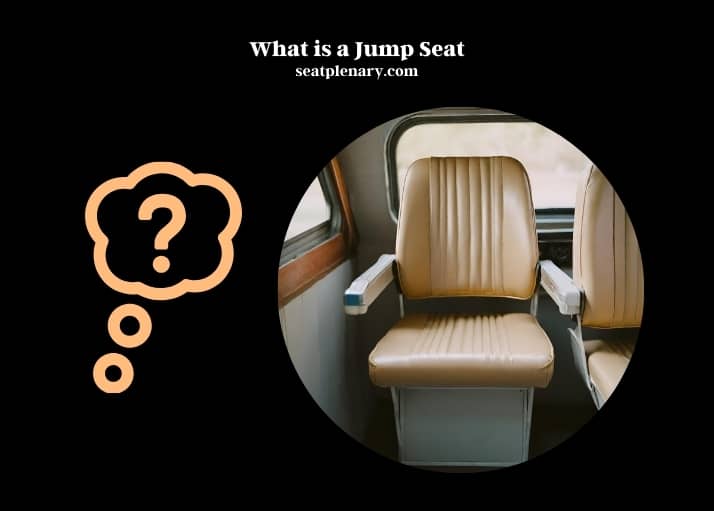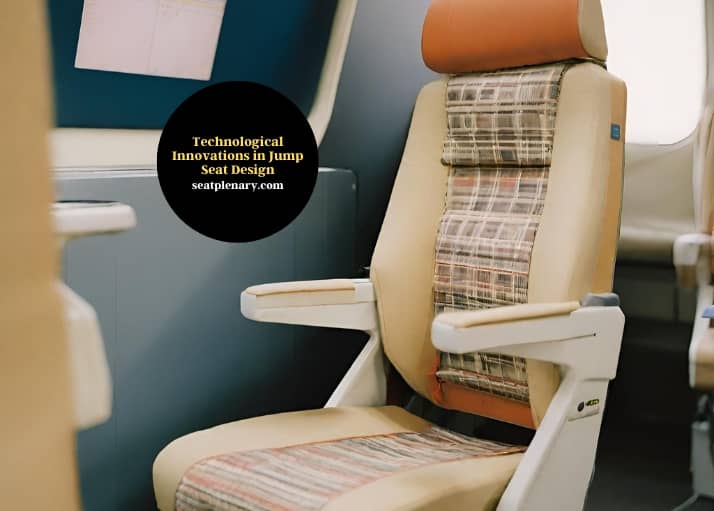A jump seat refers to a small, foldable seat typically used in various types of vehicles. These seats are designed to save space while providing extra seating capacity when needed.
Originating from the foldable seats in horse-drawn carriages, jump seats have evolved significantly over the years. In modern times, they are commonly found in aircraft, where they are used by flight attendants or as additional passenger seating in emergencies. In the automotive industry, jump seats are seen in large SUVs and vans, offering flexible seating arrangements. Their design focuses on being compact and easily storable, often folding away into the vehicle’s interior.

The materials used in jump seat construction vary, ranging from metals like aluminum for strength and durability to high-grade plastics and foam for comfort. Safety is a paramount consideration, especially in aviation, where jump seats must adhere to strict regulatory standards. In terms of customization, jump seats in luxury vehicles and private aircraft can be tailored to match the interior aesthetics, while those in commercial and public transport prioritize functionality and durability.
As technology advances, the future of jump seat design is poised to become even more innovative. Expect to see integration of advanced materials for enhanced safety and comfort, along with technological features like electronic controls for adjustments. The evolution of jump seats continues to reflect the changing needs and technologies of modern transportation.
The Historical Journey of Jump Seats
The concept of the jump seat has a rich history, tracing back to early vehicle designs. Initially, these seats were rudimentary, designed to maximize space in carriages and early automobiles. Over time, their presence became prominent in the aviation industry, where they evolved to meet stringent safety and ergonomic requirements.
The design of jump seats has continually adapted to the changing needs of different vehicles, including aircraft, buses, and cars. This evolution reflects a blend of practicality and innovation, as designers have worked to balance space-saving features with passenger comfort and safety.
Jump Seats Across Vehicles: Design and Utility
Jump seats are a marvel of design and functionality, serving multiple purposes across various vehicle types. In aircraft, they are crucial for cabin crew, while in buses and cars, they offer additional seating without compromising space. The design of these seats focuses on ergonomics, ensuring comfort even in limited spaces. Safety is another critical aspect, with designs incorporating features to protect passengers in emergencies.
The versatility of jump seats is evident in their ability to fold away when not in use, a feature that has made them indispensable in many transportation modes.
Safety Standards: A Comparative View
Safety is paramount in the design and use of jump seats. Various regulatory bodies set standards that these seats must meet, especially in high-risk environments like aviation. These standards encompass aspects like material strength, durability, and the seat’s ability to withstand extreme conditions.
Regular safety tests ensure that jump seats adhere to these standards, providing assurance of passenger protection. Emergency procedures also factor into the design, ensuring that the seats can be used effectively in critical situations.
Comparison of Safety Standards in Various Industries
| Industry | Safety Feature | Standard Met |
| Aviation | Material Strength | FAA Regulations |
| Automotive | Crash Test Results | Euro NCAP |
| Public Transport | Durability | DOT Standards |
Technological Innovations in Jump Seat Design
The engineering of jump seats has seen significant technological advancements. Material innovations have led to lighter, more durable seats. Foldable designs have become more sophisticated, allowing for easier storage and accessibility. The integration of technology, such as electronic adjustment controls, has enhanced the functionality of these seats. These advancements reflect the ongoing effort to improve the efficiency and comfort of jump seats in various settings.

Jump Seats Beyond Transportation: A Cultural and Practical Perspective
Jump seats have transcended their traditional role in transportation, influencing culture and practical applications in diverse settings. They are often referenced in pop culture, symbolizing adaptability and resourcefulness. In homes and public spaces, jump seats offer innovative solutions for space utilization and ergonomic seating. Their creative uses extend beyond their original purpose, showcasing their versatility and adaptability in various environments.
Survey on Jump Seat Usage in Non-Transportation Settings
| Setting | Percentage of Use |
| Homes | 35% |
| Public Spaces | 25% |
| Recreational Vehicles | 40% |
FAQs
Who Invented the Jump Seat?
The invention of the jump seat is not attributed to a single individual but evolved over time. Its origins can be traced back to horse-drawn carriages of the 18th century. These early versions were simple, foldable seats used to accommodate extra passengers or servants. As transportation evolved, so did the design and purpose of the jump seat, adapting to the needs of different vehicles, from carriages to modern aircraft and vehicles.
What Materials Are Used in Jump Seat Construction?
Jump seats are constructed from a variety of materials, each chosen for durability, safety, and comfort. Common materials include aluminum for its lightweight and strength, high-grade plastics for flexibility and cost-effectiveness, and foam padding for comfort. In vehicles where weight is a critical factor, like airplanes, advanced composites and lightweight metals are often used. The choice of material depends on the specific requirements of the vehicle and its intended use.
Can Jump Seats Be Customized?
Customization of jump seats is possible and often depends on their intended use and the vehicle they are in. In luxury vehicles and private aircraft, jump seats can be customized with high-end materials, additional padding, and specific color schemes to match the interior. In commercial and public transportation, customization might focus more on durability and ease of cleaning rather than aesthetic appeal.
Are Jump Seats Safe for Children?
The safety of jump seats for children depends on the specific design and the safety standards of the vehicle. In many cases, jump seats are not designed with child safety restraints, making them unsuitable for young children or infants. It’s always recommended to use proper child safety seats that are designed according to age, weight, and height specifications.
How Do Jump Seats Impact Vehicle Space?
Jump seats are designed to maximize space efficiency in vehicles. When not in use, they can be folded away, often disappearing into the vehicle’s interior or wall, thereby freeing up space. This feature is particularly valuable in environments where space is at a premium, such as in small cars, airplanes, and multi-purpose vehicles.
What Is the Future of Jump Seat Design?
The future of jump seat design is likely to be influenced by advancements in materials and technology. Expect to see lighter, stronger materials that offer increased comfort and safety. Technological integration, such as electronic controls for adjustment and deployment, could also become more common. Additionally, as autonomous and electric vehicles become more prevalent, the design of jump seats may evolve to suit new interior layouts that differ from traditional vehicle designs.
Summary
The journey of the jump seat from a simple, space-saving solution to a multifaceted component in various industries highlights its significance. Its evolution, driven by the need for efficiency, safety, and adaptability, showcases the ingenuity of design and engineering. Beyond its practical use in transportation, the jump seat has found a place in our cultural landscape, symbolizing versatility and innovation. This exploration into the world of jump seats reveals their indispensable role in modern society, extending far beyond their initial purpose.
